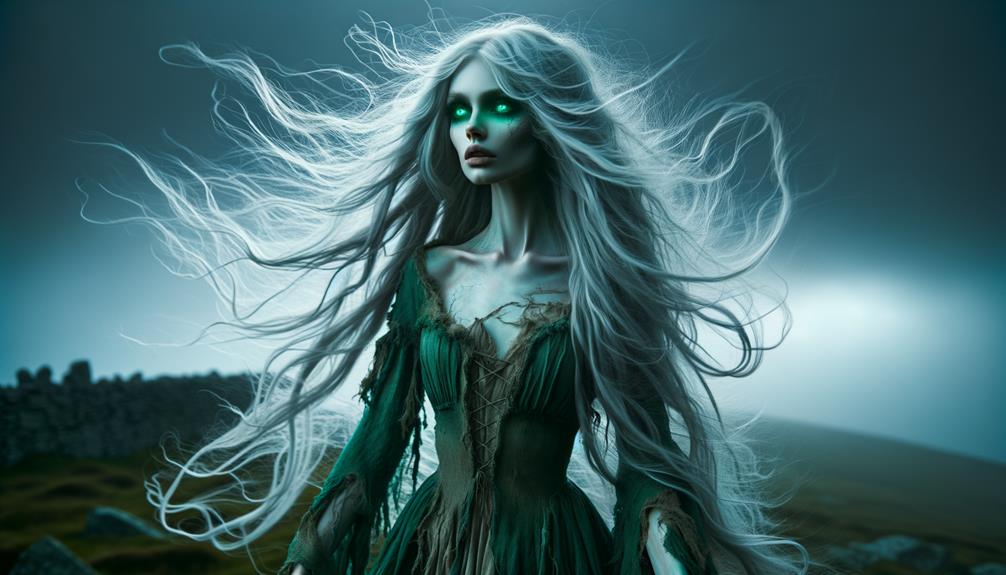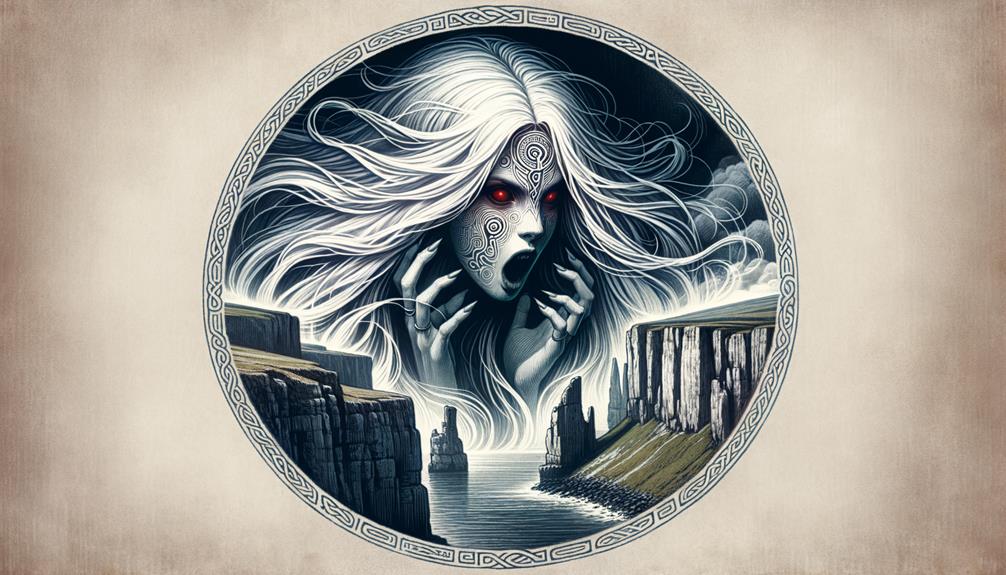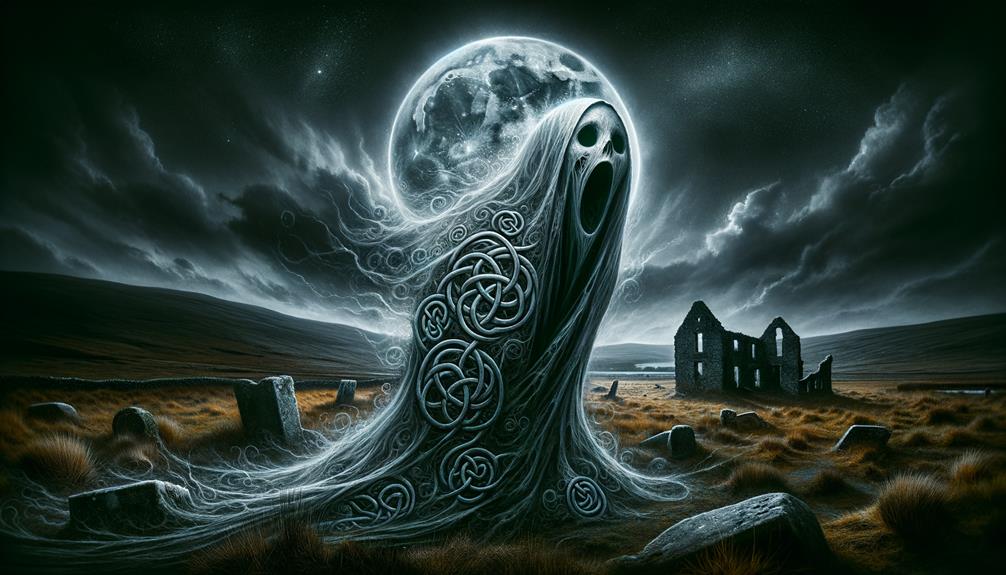Let's chat about the Banshee, a fascinating figure from Irish folklore. This spirit is famous for her sorrowful wail, which many people think is a sign that someone is about to die. The Banshee is closely tied to ancient Irish families, which really highlights her importance in Irish culture. She's got this cool ability to change her appearance, sometimes looking like an old woman crying out in grief, and other times appearing as a creature straight out of a fairy tale. She really embodies how the Irish think about death. You can find her mournful cry echoing in many literary works, adding to the air of mystery around her story. There's so much more to learn about this intriguing ghostly figure from the rich world of Irish mythology.
Origins of the Banshee
Let's get chatty about the Banshee, shall we? This eerie spirit actually takes us on a throwback to the times of medieval keeners. These were folks, mainly women, who were paid to sing some pretty gloomy tunes at funerals. Their wails, filled with emotion, were like encapsulating the collective grief and sorrow of those present.
The Banshee legend seems to have been inspired by these keeners. Over time, people started believing in a fairy woman who would show up at funerals, wailing and grieving. This belief slowly morphed into what we now know as the Banshee. The Banshee's wail, also known as 'caoine,' got a reputation for predicting death. Hearing it meant someone was about to meet their maker.
What's really interesting about the Banshee is how she evolved from a basic keener into a ghostly figure linked to specific Irish families. This family connection is a big part of the Banshee legend. The O'Neills and O'Connors, for example, were said to have their very own Banshees. This personal touch made the Banshee's wail even more impactful. It wasn't just a sign of any death, but a warning of a forthcoming family tragedy.
Appearance and Characteristics

Let's dive into the captivating world of the Banshee, a character straight out of Celtic folklore. Picture this – a figure with long, flowing hair and constantly weeping red eyes. She's dressed in a grey cloak over a green dress, symbolizing the gloomy Irish winters.
The Banshee isn't one-size-fits-all. She can be as small as a foot or tower at four feet. Sometimes, she's seen as an old woman, other times, as a mythical fairy creature. What makes her truly spine-chilling, however, is her keening, a mournful cry that signals an imminent death in the family.
But not just any family gets a visit from this spectral figure. It's a privilege reserved for the descendants of certain ancient Irish families, especially those with surnames beginning with 'Mc/Mac'. Let's break down her characteristics further:
| Characteristics | Details |
|---|---|
| Appearance | Long, flowing hair, red eyes, grey cloak over a green dress |
| Height | Ranges from a foot to four feet tall |
| Identity | Sometimes seen as an old woman, sometimes a fairy creature |
| Keening | A mournful cry that signals impending death |
| Families | Reserved for descendants of certain ancient Irish families |
The Banshee is not unique to Irish folklore. Variations of her can be found in many cultures, making her a globally recognized spirit of death.
Banshees Cultural Influence

Banshees, these fascinating figures from Irish folklore, have certainly left their mark on literature and culture. Renowned authors such as Emily Bronte and Oscar Wilde have included them in their works, presenting them as ghostly spirits with a knack for predicting death. Their haunting presence has enriched Irish stories for hundreds of years, lending a spine-tingling atmosphere that keeps readers hooked.
And it's not just in books that you'll find these supernatural beings. To give you a better understanding:
- They're tied to ancient Irish families, often depicted as guardians who sound the alarm of upcoming disaster.
- They're known for their ability to transform into different forms, adding to their enigmatic character.
- Even though they might scare us a bit, some stories show them as guides to the Otherworld, highlighting their complex roles in folklore.
The banshees' supernatural characteristics have not only sparked a sense of wonder and dread, but they've also helped shape a distinctive cultural identity. These creatures, known for their eerie cries and predictive powers, are now synonymous with Irish heritage. Their impact goes beyond literature and myths, seeping into the very essence of what it means to be Irish.
Famous Banshee Legends

Let's talk about some popular banshee legends, focusing particularly on stories related to the well-known O'Neills and O'Connors families. These tales are deeply rooted in banshee mythology, with each family supposedly having a dedicated banshee. It's believed that when a family member's death is near, the banshees sing sorrowful tunes, their cries serving as an uncanny warning.
The O'Neill family, an influential Irish clan, reportedly has a banshee that alerts them of an impending death with her mournful wails. The O'Connors, another influential family, have a similar story. These legends, passed down from generation to generation, contribute significantly to the banshee's mythical standing.
The banshee's wails are a powerful sign of looming disaster for these particular Irish families, and in fact, for the whole country. These stories highlight the banshee's role as a messenger of death, making her a frightening but intriguing character in Irish folklore. As such, the banshee legends have become an integral part of the cultural identity of Irish families, emphasizing the significance of heritage and family bonds.
Symbolism and Interpretations

Let's chat about the symbolism and interpretations tucked into the tales of the banshee in Irish folklore. This shrieking spirit is known as a creepy sign of death, specifically linked to certain old Irish families like the O'Neills and O'Connors. The banshee, a female spirit, uses sorrowful cries, or keening, as a chilling warning of a nearing death. Her existence is deeply rooted in Irish mythology and is closely linked to grieving.
- The banshee's heart-rending keening is more than a sad cry. It's a frightful sound that signals an impending death.
- This spirit is closely connected to specific Irish families. It suggests a profound, ancestral bond between the banshee and the families she grieves for.
- Her being a female spirit highlights the conventional role of women in Irish society as those who mourn and care for the deceased.
The Banshee is interpreted in different ways, but there's a universal thread in all the stories – she's seen as a warning of death and a representation of the Irish people's deep regard for, and fear of, the unavoidable end of life.
Frequently Asked Questions
What Does It Mean When a Banshee Is Wailing?
You know, according to Irish legends, the wailing of a banshee is seen as a sign of impending death. It's like a spooky heads-up, signaling that someone in the family is about to pass away. This haunting spirit's cry is a kind of grim alarm bell, marking a forthcoming end in the family it chooses to visit.
What Irish Spirit Is Known for Wailing?
Hey, did you know about the banshee from Irish folklore? She's famous for her wailing, and it's not just any kind of noise. It's a creepy, bone-chilling cry that's been woven into the fabric of Irish culture and superstitions over the years. Some people even believe that her wail is a sign of impending death. Pretty spooky, right? But you have to admit, it's an intriguing part of the mythology from Ireland.
What Is a Banshee Wail?
Have you ever heard of a banshee's wail? It's this haunting sound, believed to predict an upcoming death. This chilling cry can vary from a sorrowful song to a terrifying scream. It's known to be a sort of ghostly warning, particularly linked with certain Irish families. Quite eerie, isn't it?
Who Does the Banshee Cry For?
You know, there's this fascinating piece of lore about the Banshee. Apparently, her eerie cry is specifically meant for some old Irish families, often those with surnames starting with 'Mc' or 'Mac'. But here's the intriguing part – it's said that if you're blessed with a knack for music, you might hear her sorrowful wail too, no matter what your family tree looks like. Isn't that interesting?


